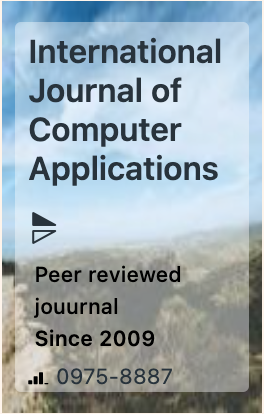The week's pick
Random Articles
Reseach Article
Medication Identification and Assistive System for the Visually Impaired: Vismed
| International Journal of Computer Applications |
| Foundation of Computer Science (FCS), NY, USA |
| Volume 186 - Number 38 |
| Year of Publication: 2024 |
| Authors: Shibakali Gupta, Sumana Das, Surabhi Pal |
 10.5120/ijca2024923958
10.5120/ijca2024923958
|
Shibakali Gupta, Sumana Das, Surabhi Pal . Medication Identification and Assistive System for the Visually Impaired: Vismed. International Journal of Computer Applications. 186, 38 ( Sep 2024), 30-33. DOI=10.5120/ijca2024923958
Abstract
Visual impairment poses significant challenges for individuals in independently managing their everyday activities and medication regimens. 39 million people are designated as blind by the World Health Organisation (WHO), out of an estimated 285 million people who have visual impairment. Many people have to face difficulties in interpreting prescriptions, recognizing medications, and administering them properly, which can lead to serious health hazards and reduce the sense of autonomy. An innovative Artificial Intelligence (AI)--driven Blind Assistive System, VISMED has been developed to address these critical problems. This advanced system empowers visually impaired individuals to scan their prescriptions and extract medication details using Optical Character Recognition (OCR) technology by accessing a comprehensive database. It also optimizes the prescription writing process for healthcare professionals by incorporating an online prescription service and primary disease predictive model using machine learning. Furthermore, the application has a provision for emergency communication with caregivers in times of dire need. Combining these features, it seeks to significantly improve the independence, health, and overall quality of life of individuals with visual impairments. By leveraging cutting-edge technologies, this system meets the needs of the visually impaired population in terms of accessibility and healthcare management. The necessity of such a system is of supreme importance, as it improves drug safety and accuracy in medication use while encouraging greater autonomy and self-reliance among visually impaired individuals, ultimately contributing to their better state of health and increased involvement in society.
References
- Jiaji Wang, Shuihua Wang, Yudong Zhang, ‘Artificial Intelligence for Visually impaired’ .2023.
- ‘Evaluating AI Techniques for Blind Students Using Voice-Activated Personal Assistants’, Tariq S Almurayziq, Gharbi Khamis Alshammari, Abdullah Alshammari, Mohammad Alsaffar and Saud Aljaloud,2022.
- ‘Assistive System for the Blind with Voice Output Based on Optical Character Recognition’, D.Dhinakaran D.Selvaraj, S.M.Udhaya Shankar, S.Pavitrah and R.Bhoomika, CICC 2022
- ‘AI-Based App for Blind People’Tufel Ali Qureshi, Mahima Rajbhar , Yukta Pisat, Prof. Vijay Bhosale,2021, International Research Journal of Engineering and Technology (IRJET) e-ISSN: 2395-0056, p-ISSN: 2395-0072
- ‘Smart Reader for Visually Impaired People Based on Optical Character Recognition’ , Muhammad Farid Zamir(&), Khan Bahadar Khan, Shafquat Ahmmad Khan, and Eid Rehman, Springer Nature Singapore Pte Ltd. 2020 I. S. Bajwa et al. (Eds.): INTAP 2019, CCIS 1198, pp. 79–89, 2020.
- Rinkal Keniya, Aman Khakharia, Vruddhi Shah, Vrushabh Gada, Ruchi Manjalkar, Tirth Thaker, Mahesh Warang, Ninad Mehendale, ‘Disease prediction from various symptoms using machine learning’.
- Wafa Elmannai, Khaled Elleithyi, ‘Sensor-Based Assistive Devices for Visually-Impaired People: Current Status, Challenges, and Future Directions’.
- Shonal Chaudhry, Rohitash Chandra, ‘Design of a Mobile Face Recognition System for Visually Impaired Person’.
- Ashwani Kumar, Ankush Chourasia, ‘Blind Navigation System Using Artificial Intelligence’.
Index Terms
Keywords

